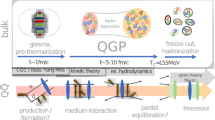Summary
In a scenario where the down and strange quark weak-interaction eigenstates are given a current mass, it is argued that a likely pattern of chiral symmetry breaking is one in which\(\left\langle {\bar uu} \right\rangle ,\left\langle {\bar dd} \right\rangle \) and\(\left\langle {\bar sd} \right\rangle = \left\langle {\bar ds} \right\rangle \) condensates form, the latter either instead of, or in addition to, an\(\left\langle {\bar ss} \right\rangle \) condensate. This results in a dynamical mixing contribution to the effectives-d mass matrix. Using previous estimates of quark mass ratios, the resulting Cabibbo angle is computed to be (13±4)°. A consistent solution is reached with zero Lagrangian mass for the up quark, providing a possible solution to the strongCP problem. In the absence of weak interactions,\(\left\langle {\bar sd} \right\rangle = \left\langle {\bar ds} \right\rangle = 0\), but\(\lim x \to \infty \left\langle {\bar s(x) d(x) \bar d(0) s(0)} \right\rangle \ne 0\), corresponding to a condensate of spatially noncorrelated\(\bar sd/\bar ds\) pairs, and plays a nearly identical role. Pauli-principle effects give this pair-condensed vacuum a lower energy than the usual spontaneously broken vacuum solution, and produces an allowed violation of cluster decomposition. Strangeness is not spontaneously broken, and no unwanted Goldstone bosons result.
Similar content being viewed by others
References
R. Serber: inThe Birth of Particle Physics, edited byL. M. Brown andL. Hoddeson (Cambridge University Press, Cambridge, 1983), p. 217.
G.’t Hooft:Phys. Rev. Lett.,37, 8 (1976);Phys. Rev. D,14, 3432 (1976).
L. Susskind:Phys. Rev. D,20, 2619 (1979),S. Weinberg:Phys. Rev. D,19, 1277 (1979).
H. D. Politzer:Nucl. Phys. B,117, 397 (1976);M. D. Scadron:Ann. Phys. (N.Y.),148, 257 (1983);V. Elias andM. D. Scadron:Phys. Rev. D,30, 647 (1984).
A. Chodos, R. L. Jaffe, K. Johnson, C. B. Thorn andV. F. Weisskopf:Phys. Rev. D,9, 3471 (1974);A. Chodos, R. L. Jaffe, K. Johnson andC. B. Thorn:Phys. Rev. D,10, 2599 (1974);T. DeGrand, R. L. Jaffe, K. Johnson andJ. Kiskis:Phys. Rev. D,12, 2060 (1975).
See, for instance,A. de Shalit andH. Feshbach:Theoretical Nuclear Physics, Vol.1 (John Wiley and Sons, New York, N.Y., 1974), p. 126.
M. Kobayashi andT. Maskawa:Prog. Theor. Phys.,49, 652 (1973).
Particle Data Group:Phys. Lett. B,239, 1 (1990).
J. Gasser andH. Leutwyler:Phys. Rep.,87, 77 (1982);Ann. Phys. (N.Y.),158, 142 (1984);Nucl. Phys. B,250, 465 (1985).
F. E. Close:Introduction to Quarks and Partons (Academic Press, New York, N.Y., 1979), p. 127.
W. Feilmair, M. Faber andH. Markum:Phys. Rev. D,39, 1409 (1989).
T.-P. Cheng andL.-F. Li:Gauge Theory of Elementary Particle Physics (Oxford University Press, New York, N.Y., 1984), p. 408.
Author information
Authors and Affiliations
Rights and permissions
About this article
Cite this article
Grady, M. Cabibbo mixing from strong-interaction condensates. Nuov Cim A 105, 1065–1079 (1992). https://doi.org/10.1007/BF02730866
Received:
Accepted:
Published:
Issue Date:
DOI: https://doi.org/10.1007/BF02730866




